Risk Management Essay: Analysis of the MBS and Subprime Crisis
VerifiedAdded on 2023/01/05
|8
|2360
|22
Essay
AI Summary
This essay examines the role of Mortgage Backed Securities (MBS) in the 2007-2010 subprime mortgage crisis. It explains how MBSs, designed to reduce bank risk through securitization and diversification, contributed to the crisis. The essay details the mechanics of MBSs, including how individual home loans are pooled and sold to investors. It highlights the benefits, such as risk reduction for banks and increased lending capacity, while also outlining the risks, including prepayment and extension risks. The essay discusses how the pursuit of profits led to a decline in due diligence and the issuance of subprime and NINJA loans, ultimately contributing to the collapse of the housing market. It also analyzes the failure of geographical diversification, the interconnectedness of financial institutions, and the resulting global economic impact. The essay concludes by emphasizing the increased importance of geographical diversification in the face of changing global dynamics and increased conflicts.
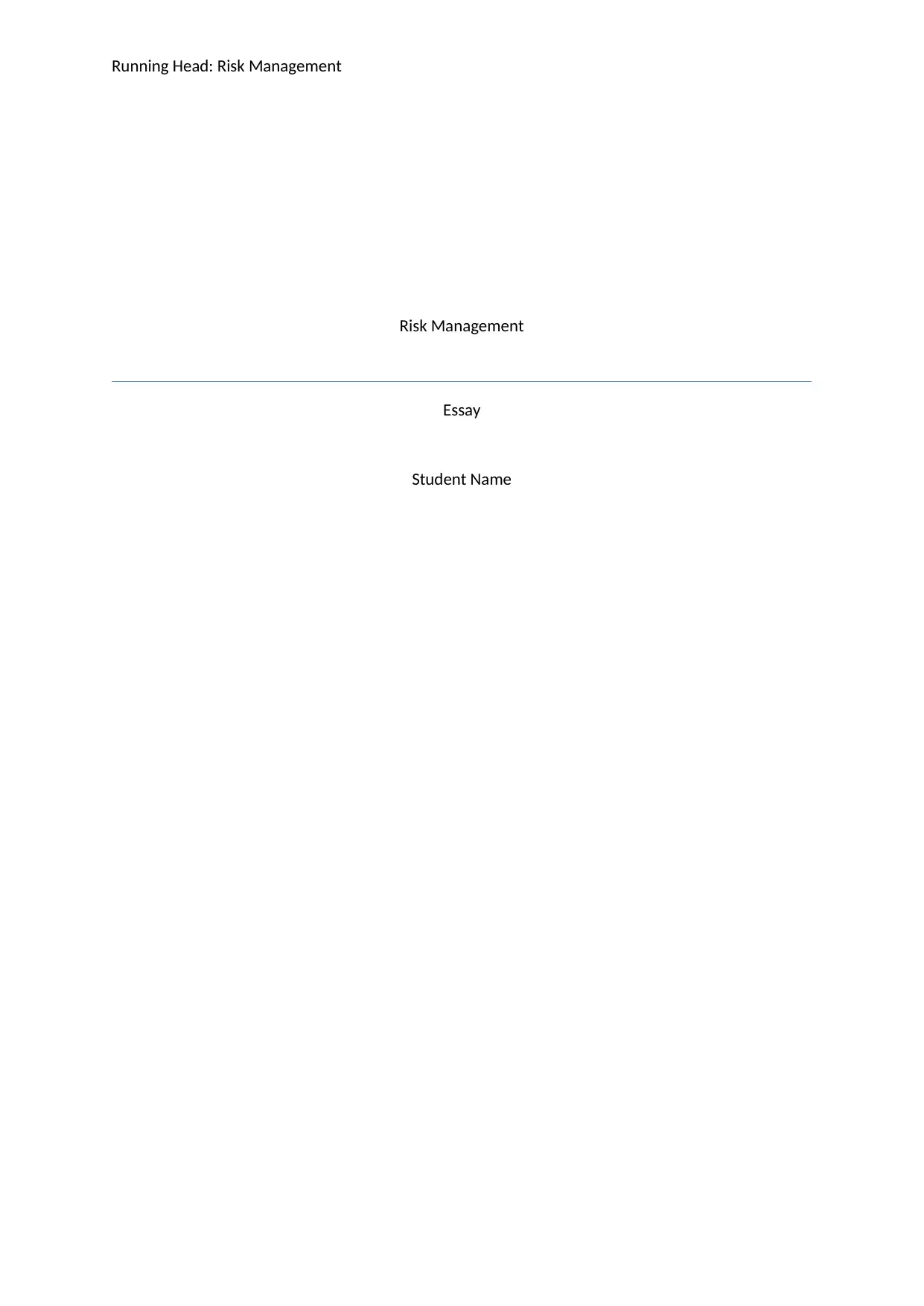
Running Head: Risk Management
Risk Management
Essay
Student Name
Risk Management
Essay
Student Name
Paraphrase This Document
Need a fresh take? Get an instant paraphrase of this document with our AI Paraphraser
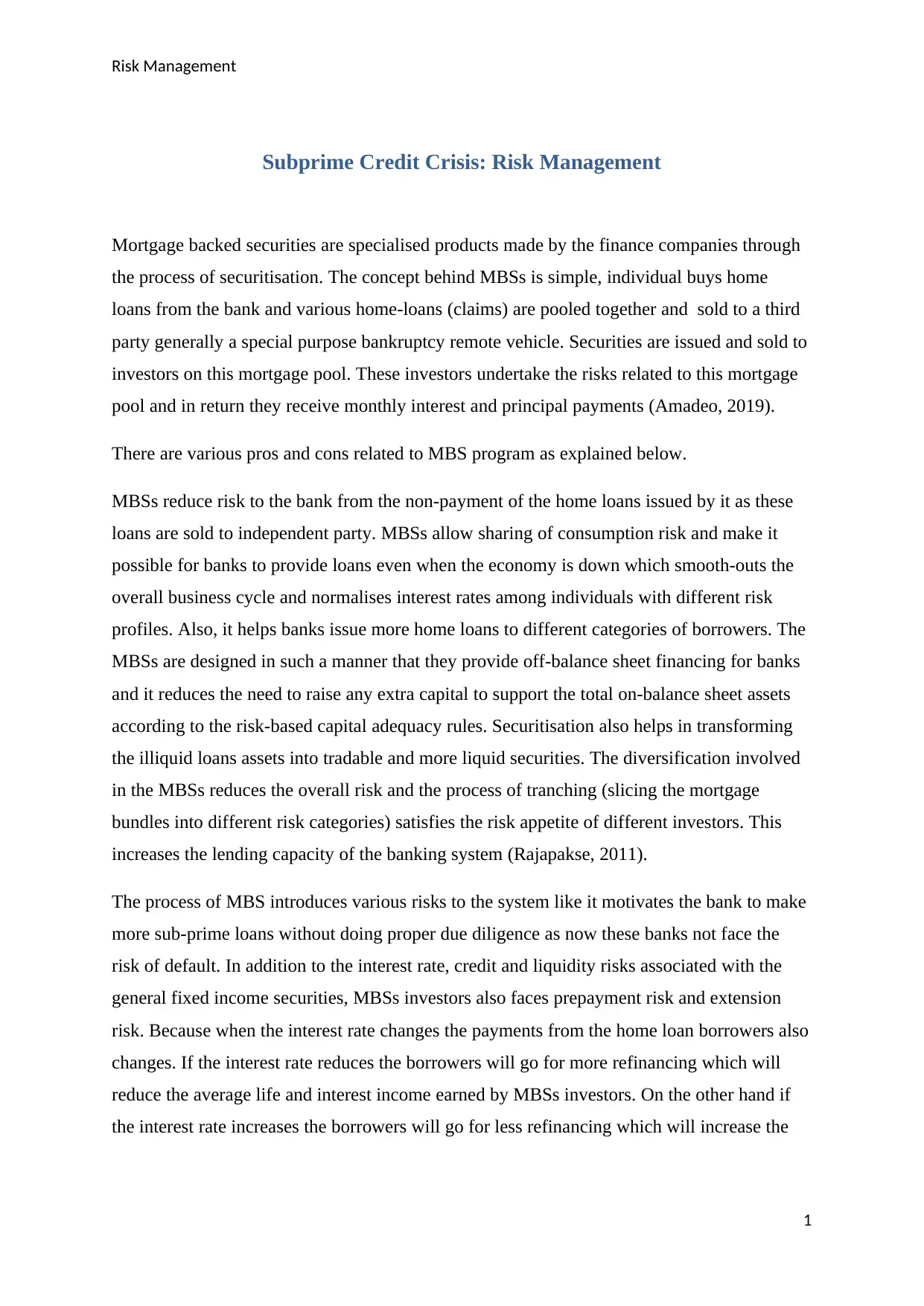
Risk Management
Subprime Credit Crisis: Risk Management
Mortgage backed securities are specialised products made by the finance companies through
the process of securitisation. The concept behind MBSs is simple, individual buys home
loans from the bank and various home-loans (claims) are pooled together and sold to a third
party generally a special purpose bankruptcy remote vehicle. Securities are issued and sold to
investors on this mortgage pool. These investors undertake the risks related to this mortgage
pool and in return they receive monthly interest and principal payments (Amadeo, 2019).
There are various pros and cons related to MBS program as explained below.
MBSs reduce risk to the bank from the non-payment of the home loans issued by it as these
loans are sold to independent party. MBSs allow sharing of consumption risk and make it
possible for banks to provide loans even when the economy is down which smooth-outs the
overall business cycle and normalises interest rates among individuals with different risk
profiles. Also, it helps banks issue more home loans to different categories of borrowers. The
MBSs are designed in such a manner that they provide off-balance sheet financing for banks
and it reduces the need to raise any extra capital to support the total on-balance sheet assets
according to the risk-based capital adequacy rules. Securitisation also helps in transforming
the illiquid loans assets into tradable and more liquid securities. The diversification involved
in the MBSs reduces the overall risk and the process of tranching (slicing the mortgage
bundles into different risk categories) satisfies the risk appetite of different investors. This
increases the lending capacity of the banking system (Rajapakse, 2011).
The process of MBS introduces various risks to the system like it motivates the bank to make
more sub-prime loans without doing proper due diligence as now these banks not face the
risk of default. In addition to the interest rate, credit and liquidity risks associated with the
general fixed income securities, MBSs investors also faces prepayment risk and extension
risk. Because when the interest rate changes the payments from the home loan borrowers also
changes. If the interest rate reduces the borrowers will go for more refinancing which will
reduce the average life and interest income earned by MBSs investors. On the other hand if
the interest rate increases the borrowers will go for less refinancing which will increase the
1
Subprime Credit Crisis: Risk Management
Mortgage backed securities are specialised products made by the finance companies through
the process of securitisation. The concept behind MBSs is simple, individual buys home
loans from the bank and various home-loans (claims) are pooled together and sold to a third
party generally a special purpose bankruptcy remote vehicle. Securities are issued and sold to
investors on this mortgage pool. These investors undertake the risks related to this mortgage
pool and in return they receive monthly interest and principal payments (Amadeo, 2019).
There are various pros and cons related to MBS program as explained below.
MBSs reduce risk to the bank from the non-payment of the home loans issued by it as these
loans are sold to independent party. MBSs allow sharing of consumption risk and make it
possible for banks to provide loans even when the economy is down which smooth-outs the
overall business cycle and normalises interest rates among individuals with different risk
profiles. Also, it helps banks issue more home loans to different categories of borrowers. The
MBSs are designed in such a manner that they provide off-balance sheet financing for banks
and it reduces the need to raise any extra capital to support the total on-balance sheet assets
according to the risk-based capital adequacy rules. Securitisation also helps in transforming
the illiquid loans assets into tradable and more liquid securities. The diversification involved
in the MBSs reduces the overall risk and the process of tranching (slicing the mortgage
bundles into different risk categories) satisfies the risk appetite of different investors. This
increases the lending capacity of the banking system (Rajapakse, 2011).
The process of MBS introduces various risks to the system like it motivates the bank to make
more sub-prime loans without doing proper due diligence as now these banks not face the
risk of default. In addition to the interest rate, credit and liquidity risks associated with the
general fixed income securities, MBSs investors also faces prepayment risk and extension
risk. Because when the interest rate changes the payments from the home loan borrowers also
changes. If the interest rate reduces the borrowers will go for more refinancing which will
reduce the average life and interest income earned by MBSs investors. On the other hand if
the interest rate increases the borrowers will go for less refinancing which will increase the
1
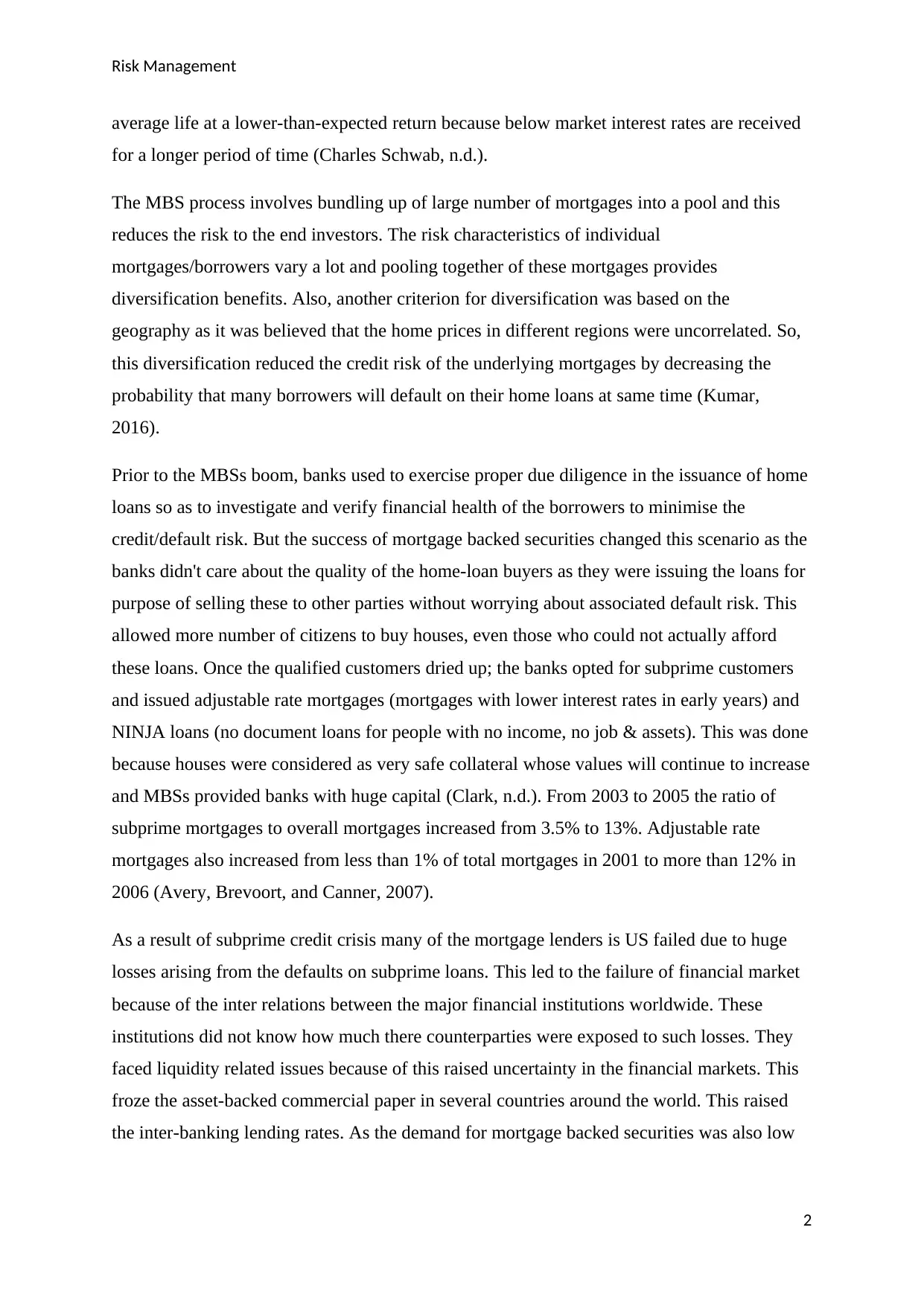
Risk Management
average life at a lower-than-expected return because below market interest rates are received
for a longer period of time (Charles Schwab, n.d.).
The MBS process involves bundling up of large number of mortgages into a pool and this
reduces the risk to the end investors. The risk characteristics of individual
mortgages/borrowers vary a lot and pooling together of these mortgages provides
diversification benefits. Also, another criterion for diversification was based on the
geography as it was believed that the home prices in different regions were uncorrelated. So,
this diversification reduced the credit risk of the underlying mortgages by decreasing the
probability that many borrowers will default on their home loans at same time (Kumar,
2016).
Prior to the MBSs boom, banks used to exercise proper due diligence in the issuance of home
loans so as to investigate and verify financial health of the borrowers to minimise the
credit/default risk. But the success of mortgage backed securities changed this scenario as the
banks didn't care about the quality of the home-loan buyers as they were issuing the loans for
purpose of selling these to other parties without worrying about associated default risk. This
allowed more number of citizens to buy houses, even those who could not actually afford
these loans. Once the qualified customers dried up; the banks opted for subprime customers
and issued adjustable rate mortgages (mortgages with lower interest rates in early years) and
NINJA loans (no document loans for people with no income, no job & assets). This was done
because houses were considered as very safe collateral whose values will continue to increase
and MBSs provided banks with huge capital (Clark, n.d.). From 2003 to 2005 the ratio of
subprime mortgages to overall mortgages increased from 3.5% to 13%. Adjustable rate
mortgages also increased from less than 1% of total mortgages in 2001 to more than 12% in
2006 (Avery, Brevoort, and Canner, 2007).
As a result of subprime credit crisis many of the mortgage lenders is US failed due to huge
losses arising from the defaults on subprime loans. This led to the failure of financial market
because of the inter relations between the major financial institutions worldwide. These
institutions did not know how much there counterparties were exposed to such losses. They
faced liquidity related issues because of this raised uncertainty in the financial markets. This
froze the asset-backed commercial paper in several countries around the world. This raised
the inter-banking lending rates. As the demand for mortgage backed securities was also low
2
average life at a lower-than-expected return because below market interest rates are received
for a longer period of time (Charles Schwab, n.d.).
The MBS process involves bundling up of large number of mortgages into a pool and this
reduces the risk to the end investors. The risk characteristics of individual
mortgages/borrowers vary a lot and pooling together of these mortgages provides
diversification benefits. Also, another criterion for diversification was based on the
geography as it was believed that the home prices in different regions were uncorrelated. So,
this diversification reduced the credit risk of the underlying mortgages by decreasing the
probability that many borrowers will default on their home loans at same time (Kumar,
2016).
Prior to the MBSs boom, banks used to exercise proper due diligence in the issuance of home
loans so as to investigate and verify financial health of the borrowers to minimise the
credit/default risk. But the success of mortgage backed securities changed this scenario as the
banks didn't care about the quality of the home-loan buyers as they were issuing the loans for
purpose of selling these to other parties without worrying about associated default risk. This
allowed more number of citizens to buy houses, even those who could not actually afford
these loans. Once the qualified customers dried up; the banks opted for subprime customers
and issued adjustable rate mortgages (mortgages with lower interest rates in early years) and
NINJA loans (no document loans for people with no income, no job & assets). This was done
because houses were considered as very safe collateral whose values will continue to increase
and MBSs provided banks with huge capital (Clark, n.d.). From 2003 to 2005 the ratio of
subprime mortgages to overall mortgages increased from 3.5% to 13%. Adjustable rate
mortgages also increased from less than 1% of total mortgages in 2001 to more than 12% in
2006 (Avery, Brevoort, and Canner, 2007).
As a result of subprime credit crisis many of the mortgage lenders is US failed due to huge
losses arising from the defaults on subprime loans. This led to the failure of financial market
because of the inter relations between the major financial institutions worldwide. These
institutions did not know how much there counterparties were exposed to such losses. They
faced liquidity related issues because of this raised uncertainty in the financial markets. This
froze the asset-backed commercial paper in several countries around the world. This raised
the inter-banking lending rates. As the demand for mortgage backed securities was also low
2
⊘ This is a preview!⊘
Do you want full access?
Subscribe today to unlock all pages.

Trusted by 1+ million students worldwide
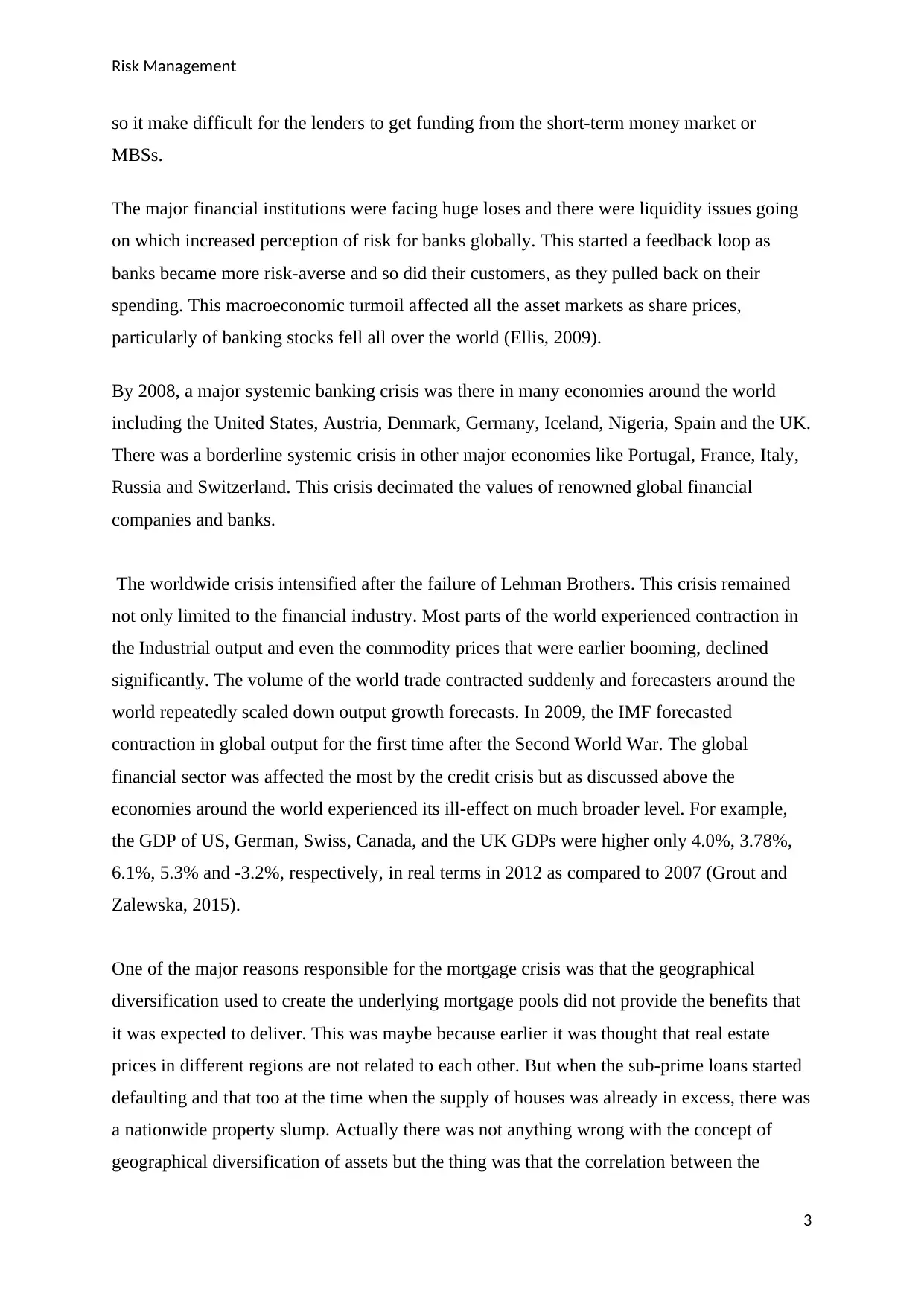
Risk Management
so it make difficult for the lenders to get funding from the short-term money market or
MBSs.
The major financial institutions were facing huge loses and there were liquidity issues going
on which increased perception of risk for banks globally. This started a feedback loop as
banks became more risk-averse and so did their customers, as they pulled back on their
spending. This macroeconomic turmoil affected all the asset markets as share prices,
particularly of banking stocks fell all over the world (Ellis, 2009).
By 2008, a major systemic banking crisis was there in many economies around the world
including the United States, Austria, Denmark, Germany, Iceland, Nigeria, Spain and the UK.
There was a borderline systemic crisis in other major economies like Portugal, France, Italy,
Russia and Switzerland. This crisis decimated the values of renowned global financial
companies and banks.
The worldwide crisis intensified after the failure of Lehman Brothers. This crisis remained
not only limited to the financial industry. Most parts of the world experienced contraction in
the Industrial output and even the commodity prices that were earlier booming, declined
significantly. The volume of the world trade contracted suddenly and forecasters around the
world repeatedly scaled down output growth forecasts. In 2009, the IMF forecasted
contraction in global output for the first time after the Second World War. The global
financial sector was affected the most by the credit crisis but as discussed above the
economies around the world experienced its ill-effect on much broader level. For example,
the GDP of US, German, Swiss, Canada, and the UK GDPs were higher only 4.0%, 3.78%,
6.1%, 5.3% and -3.2%, respectively, in real terms in 2012 as compared to 2007 (Grout and
Zalewska, 2015).
One of the major reasons responsible for the mortgage crisis was that the geographical
diversification used to create the underlying mortgage pools did not provide the benefits that
it was expected to deliver. This was maybe because earlier it was thought that real estate
prices in different regions are not related to each other. But when the sub-prime loans started
defaulting and that too at the time when the supply of houses was already in excess, there was
a nationwide property slump. Actually there was not anything wrong with the concept of
geographical diversification of assets but the thing was that the correlation between the
3
so it make difficult for the lenders to get funding from the short-term money market or
MBSs.
The major financial institutions were facing huge loses and there were liquidity issues going
on which increased perception of risk for banks globally. This started a feedback loop as
banks became more risk-averse and so did their customers, as they pulled back on their
spending. This macroeconomic turmoil affected all the asset markets as share prices,
particularly of banking stocks fell all over the world (Ellis, 2009).
By 2008, a major systemic banking crisis was there in many economies around the world
including the United States, Austria, Denmark, Germany, Iceland, Nigeria, Spain and the UK.
There was a borderline systemic crisis in other major economies like Portugal, France, Italy,
Russia and Switzerland. This crisis decimated the values of renowned global financial
companies and banks.
The worldwide crisis intensified after the failure of Lehman Brothers. This crisis remained
not only limited to the financial industry. Most parts of the world experienced contraction in
the Industrial output and even the commodity prices that were earlier booming, declined
significantly. The volume of the world trade contracted suddenly and forecasters around the
world repeatedly scaled down output growth forecasts. In 2009, the IMF forecasted
contraction in global output for the first time after the Second World War. The global
financial sector was affected the most by the credit crisis but as discussed above the
economies around the world experienced its ill-effect on much broader level. For example,
the GDP of US, German, Swiss, Canada, and the UK GDPs were higher only 4.0%, 3.78%,
6.1%, 5.3% and -3.2%, respectively, in real terms in 2012 as compared to 2007 (Grout and
Zalewska, 2015).
One of the major reasons responsible for the mortgage crisis was that the geographical
diversification used to create the underlying mortgage pools did not provide the benefits that
it was expected to deliver. This was maybe because earlier it was thought that real estate
prices in different regions are not related to each other. But when the sub-prime loans started
defaulting and that too at the time when the supply of houses was already in excess, there was
a nationwide property slump. Actually there was not anything wrong with the concept of
geographical diversification of assets but the thing was that the correlation between the
3
Paraphrase This Document
Need a fresh take? Get an instant paraphrase of this document with our AI Paraphraser
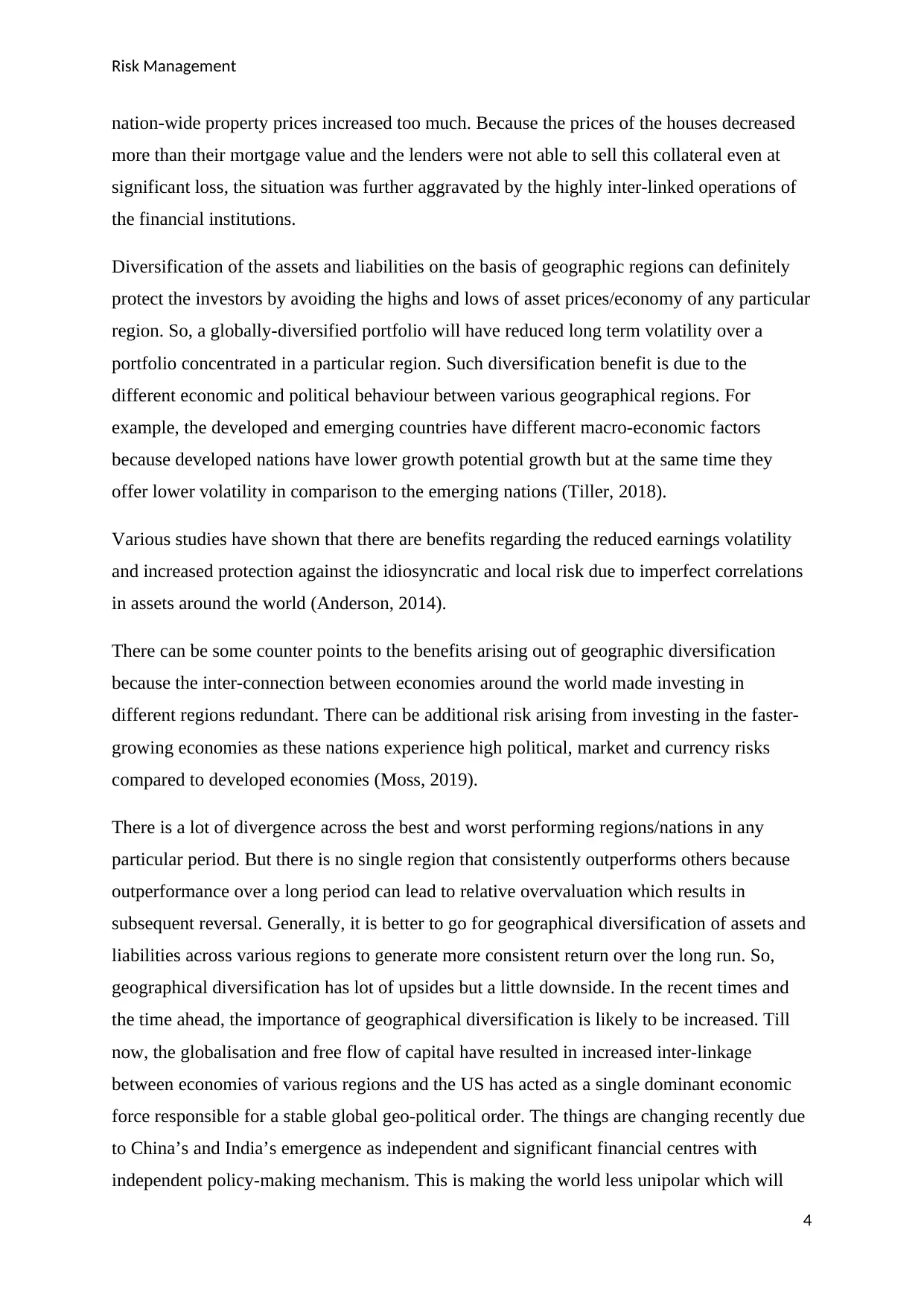
Risk Management
nation-wide property prices increased too much. Because the prices of the houses decreased
more than their mortgage value and the lenders were not able to sell this collateral even at
significant loss, the situation was further aggravated by the highly inter-linked operations of
the financial institutions.
Diversification of the assets and liabilities on the basis of geographic regions can definitely
protect the investors by avoiding the highs and lows of asset prices/economy of any particular
region. So, a globally-diversified portfolio will have reduced long term volatility over a
portfolio concentrated in a particular region. Such diversification benefit is due to the
different economic and political behaviour between various geographical regions. For
example, the developed and emerging countries have different macro-economic factors
because developed nations have lower growth potential growth but at the same time they
offer lower volatility in comparison to the emerging nations (Tiller, 2018).
Various studies have shown that there are benefits regarding the reduced earnings volatility
and increased protection against the idiosyncratic and local risk due to imperfect correlations
in assets around the world (Anderson, 2014).
There can be some counter points to the benefits arising out of geographic diversification
because the inter-connection between economies around the world made investing in
different regions redundant. There can be additional risk arising from investing in the faster-
growing economies as these nations experience high political, market and currency risks
compared to developed economies (Moss, 2019).
There is a lot of divergence across the best and worst performing regions/nations in any
particular period. But there is no single region that consistently outperforms others because
outperformance over a long period can lead to relative overvaluation which results in
subsequent reversal. Generally, it is better to go for geographical diversification of assets and
liabilities across various regions to generate more consistent return over the long run. So,
geographical diversification has lot of upsides but a little downside. In the recent times and
the time ahead, the importance of geographical diversification is likely to be increased. Till
now, the globalisation and free flow of capital have resulted in increased inter-linkage
between economies of various regions and the US has acted as a single dominant economic
force responsible for a stable global geo-political order. The things are changing recently due
to China’s and India’s emergence as independent and significant financial centres with
independent policy-making mechanism. This is making the world less unipolar which will
4
nation-wide property prices increased too much. Because the prices of the houses decreased
more than their mortgage value and the lenders were not able to sell this collateral even at
significant loss, the situation was further aggravated by the highly inter-linked operations of
the financial institutions.
Diversification of the assets and liabilities on the basis of geographic regions can definitely
protect the investors by avoiding the highs and lows of asset prices/economy of any particular
region. So, a globally-diversified portfolio will have reduced long term volatility over a
portfolio concentrated in a particular region. Such diversification benefit is due to the
different economic and political behaviour between various geographical regions. For
example, the developed and emerging countries have different macro-economic factors
because developed nations have lower growth potential growth but at the same time they
offer lower volatility in comparison to the emerging nations (Tiller, 2018).
Various studies have shown that there are benefits regarding the reduced earnings volatility
and increased protection against the idiosyncratic and local risk due to imperfect correlations
in assets around the world (Anderson, 2014).
There can be some counter points to the benefits arising out of geographic diversification
because the inter-connection between economies around the world made investing in
different regions redundant. There can be additional risk arising from investing in the faster-
growing economies as these nations experience high political, market and currency risks
compared to developed economies (Moss, 2019).
There is a lot of divergence across the best and worst performing regions/nations in any
particular period. But there is no single region that consistently outperforms others because
outperformance over a long period can lead to relative overvaluation which results in
subsequent reversal. Generally, it is better to go for geographical diversification of assets and
liabilities across various regions to generate more consistent return over the long run. So,
geographical diversification has lot of upsides but a little downside. In the recent times and
the time ahead, the importance of geographical diversification is likely to be increased. Till
now, the globalisation and free flow of capital have resulted in increased inter-linkage
between economies of various regions and the US has acted as a single dominant economic
force responsible for a stable global geo-political order. The things are changing recently due
to China’s and India’s emergence as independent and significant financial centres with
independent policy-making mechanism. This is making the world less unipolar which will
4
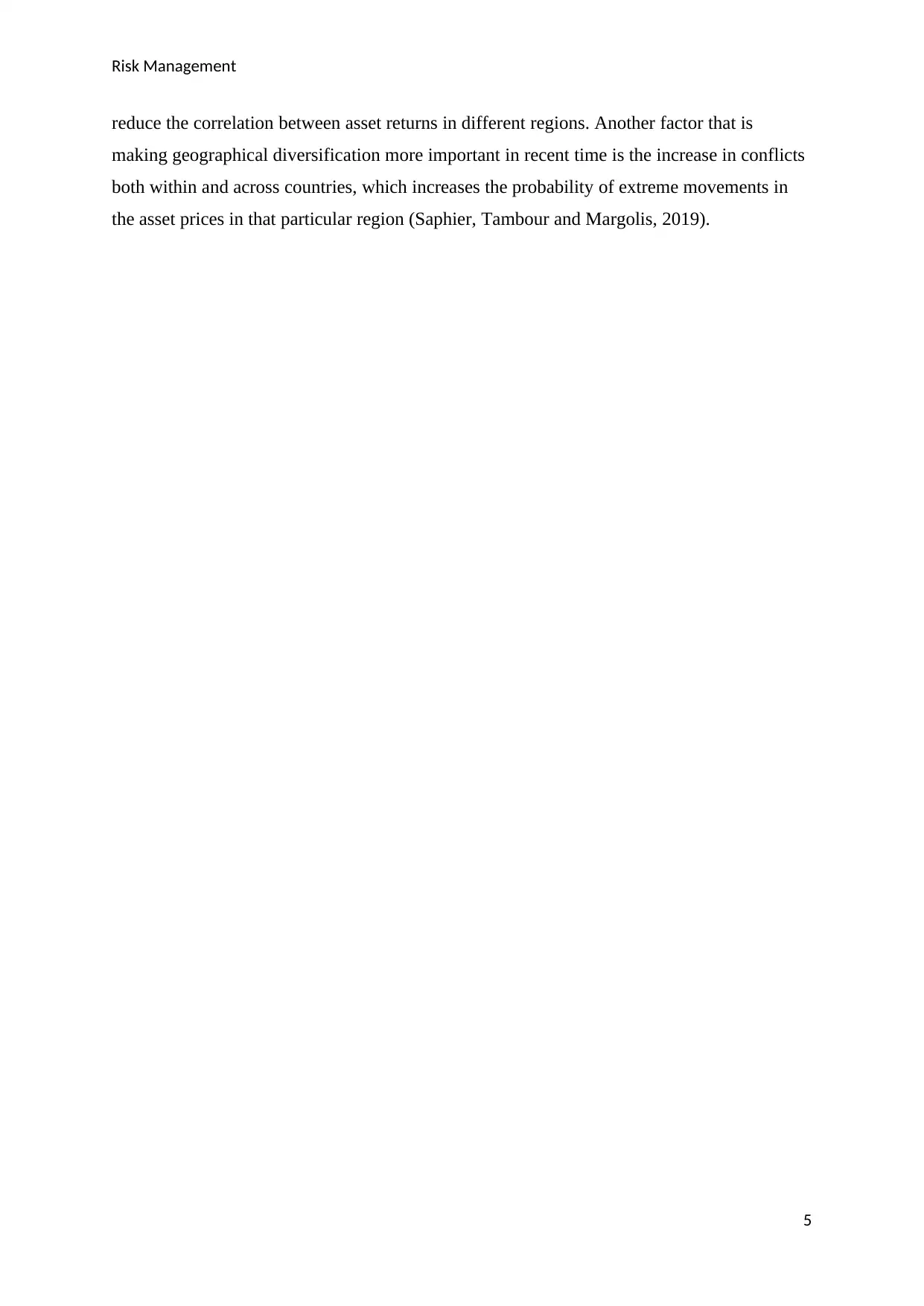
Risk Management
reduce the correlation between asset returns in different regions. Another factor that is
making geographical diversification more important in recent time is the increase in conflicts
both within and across countries, which increases the probability of extreme movements in
the asset prices in that particular region (Saphier, Tambour and Margolis, 2019).
5
reduce the correlation between asset returns in different regions. Another factor that is
making geographical diversification more important in recent time is the increase in conflicts
both within and across countries, which increases the probability of extreme movements in
the asset prices in that particular region (Saphier, Tambour and Margolis, 2019).
5
⊘ This is a preview!⊘
Do you want full access?
Subscribe today to unlock all pages.

Trusted by 1+ million students worldwide
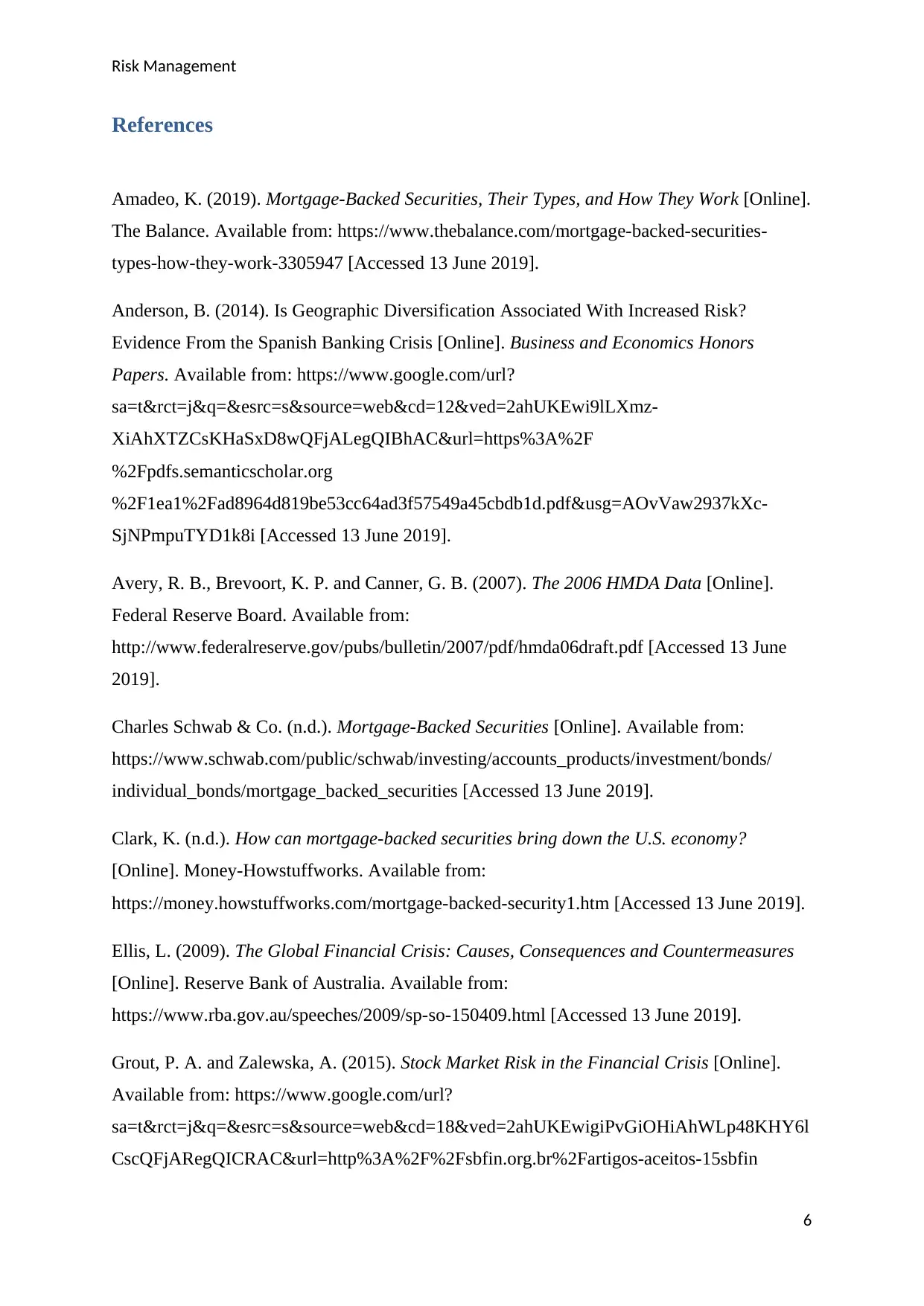
Risk Management
References
Amadeo, K. (2019). Mortgage-Backed Securities, Their Types, and How They Work [Online].
The Balance. Available from: https://www.thebalance.com/mortgage-backed-securities-
types-how-they-work-3305947 [Accessed 13 June 2019].
Anderson, B. (2014). Is Geographic Diversification Associated With Increased Risk?
Evidence From the Spanish Banking Crisis [Online]. Business and Economics Honors
Papers. Available from: https://www.google.com/url?
sa=t&rct=j&q=&esrc=s&source=web&cd=12&ved=2ahUKEwi9lLXmz-
XiAhXTZCsKHaSxD8wQFjALegQIBhAC&url=https%3A%2F
%2Fpdfs.semanticscholar.org
%2F1ea1%2Fad8964d819be53cc64ad3f57549a45cbdb1d.pdf&usg=AOvVaw2937kXc-
SjNPmpuTYD1k8i [Accessed 13 June 2019].
Avery, R. B., Brevoort, K. P. and Canner, G. B. (2007). The 2006 HMDA Data [Online].
Federal Reserve Board. Available from:
http://www.federalreserve.gov/pubs/bulletin/2007/pdf/hmda06draft.pdf [Accessed 13 June
2019].
Charles Schwab & Co. (n.d.). Mortgage-Backed Securities [Online]. Available from:
https://www.schwab.com/public/schwab/investing/accounts_products/investment/bonds/
individual_bonds/mortgage_backed_securities [Accessed 13 June 2019].
Clark, K. (n.d.). How can mortgage-backed securities bring down the U.S. economy?
[Online]. Money-Howstuffworks. Available from:
https://money.howstuffworks.com/mortgage-backed-security1.htm [Accessed 13 June 2019].
Ellis, L. (2009). The Global Financial Crisis: Causes, Consequences and Countermeasures
[Online]. Reserve Bank of Australia. Available from:
https://www.rba.gov.au/speeches/2009/sp-so-150409.html [Accessed 13 June 2019].
Grout, P. A. and Zalewska, A. (2015). Stock Market Risk in the Financial Crisis [Online].
Available from: https://www.google.com/url?
sa=t&rct=j&q=&esrc=s&source=web&cd=18&ved=2ahUKEwigiPvGiOHiAhWLp48KHY6l
CscQFjARegQICRAC&url=http%3A%2F%2Fsbfin.org.br%2Fartigos-aceitos-15sbfin
6
References
Amadeo, K. (2019). Mortgage-Backed Securities, Their Types, and How They Work [Online].
The Balance. Available from: https://www.thebalance.com/mortgage-backed-securities-
types-how-they-work-3305947 [Accessed 13 June 2019].
Anderson, B. (2014). Is Geographic Diversification Associated With Increased Risk?
Evidence From the Spanish Banking Crisis [Online]. Business and Economics Honors
Papers. Available from: https://www.google.com/url?
sa=t&rct=j&q=&esrc=s&source=web&cd=12&ved=2ahUKEwi9lLXmz-
XiAhXTZCsKHaSxD8wQFjALegQIBhAC&url=https%3A%2F
%2Fpdfs.semanticscholar.org
%2F1ea1%2Fad8964d819be53cc64ad3f57549a45cbdb1d.pdf&usg=AOvVaw2937kXc-
SjNPmpuTYD1k8i [Accessed 13 June 2019].
Avery, R. B., Brevoort, K. P. and Canner, G. B. (2007). The 2006 HMDA Data [Online].
Federal Reserve Board. Available from:
http://www.federalreserve.gov/pubs/bulletin/2007/pdf/hmda06draft.pdf [Accessed 13 June
2019].
Charles Schwab & Co. (n.d.). Mortgage-Backed Securities [Online]. Available from:
https://www.schwab.com/public/schwab/investing/accounts_products/investment/bonds/
individual_bonds/mortgage_backed_securities [Accessed 13 June 2019].
Clark, K. (n.d.). How can mortgage-backed securities bring down the U.S. economy?
[Online]. Money-Howstuffworks. Available from:
https://money.howstuffworks.com/mortgage-backed-security1.htm [Accessed 13 June 2019].
Ellis, L. (2009). The Global Financial Crisis: Causes, Consequences and Countermeasures
[Online]. Reserve Bank of Australia. Available from:
https://www.rba.gov.au/speeches/2009/sp-so-150409.html [Accessed 13 June 2019].
Grout, P. A. and Zalewska, A. (2015). Stock Market Risk in the Financial Crisis [Online].
Available from: https://www.google.com/url?
sa=t&rct=j&q=&esrc=s&source=web&cd=18&ved=2ahUKEwigiPvGiOHiAhWLp48KHY6l
CscQFjARegQICRAC&url=http%3A%2F%2Fsbfin.org.br%2Fartigos-aceitos-15sbfin
6
Paraphrase This Document
Need a fresh take? Get an instant paraphrase of this document with our AI Paraphraser

Risk Management
%2Finvestimentos%2F4868.pdf&usg=AOvVaw3Y21Q4_8TisDc0XNxikpNQ [Accessed 13
June 2019].
Kumar, D. (2016). What Caused the Financial Crisis? [Online]. NUES. Available from:
https://web.northeastern.edu/econsociety/what-caused-the-financial-crisis/ [Accessed 13 June
2019].
Moss, W. (2019). 6 Ways To Diversify Your Portfolio For Added Protection [Online].
Available from: https://www.thebalance.com/diversify-portfolio-added-protection-1289915
[Accessed 13 June 2019].
Rajapakse, P. (2011). An Analysis of the Concept of Mortgage-Backed Securities: An
Economic and Legal Perspective. Journal of Law and Financial Management [Online].
10(1). pp. 22-33. Available from:
https://www.researchgate.net/publication/228149333_An_Analysis_of_the_Concept_of_Mor
tgage-Backed_Securities_An_Economic_and_Legal_Perspective/download [Accessed 13
June 2019].
Saphier, M., Tambour, K. M. and Margolis, P. (2019). Geographic Diversification Can Be a
Lifesaver, Yet Most Portfolios Are Highly Geographically Concentrated [Online].
Bridgewater Associates. Available from:
https://www.bridgewater.com/research-library/daily-observations/geographic-diversification-
can-be-a-lifesaver/ [Accessed 13 June 2019].
Tiller (2018). Why is diversification important to managing investment risk? [Online].
Available from: https://www.tillerinvest.co.uk/blog/2018/12/21/why-is-diversification-
important/ [Accessed 13 June 2019].
7
%2Finvestimentos%2F4868.pdf&usg=AOvVaw3Y21Q4_8TisDc0XNxikpNQ [Accessed 13
June 2019].
Kumar, D. (2016). What Caused the Financial Crisis? [Online]. NUES. Available from:
https://web.northeastern.edu/econsociety/what-caused-the-financial-crisis/ [Accessed 13 June
2019].
Moss, W. (2019). 6 Ways To Diversify Your Portfolio For Added Protection [Online].
Available from: https://www.thebalance.com/diversify-portfolio-added-protection-1289915
[Accessed 13 June 2019].
Rajapakse, P. (2011). An Analysis of the Concept of Mortgage-Backed Securities: An
Economic and Legal Perspective. Journal of Law and Financial Management [Online].
10(1). pp. 22-33. Available from:
https://www.researchgate.net/publication/228149333_An_Analysis_of_the_Concept_of_Mor
tgage-Backed_Securities_An_Economic_and_Legal_Perspective/download [Accessed 13
June 2019].
Saphier, M., Tambour, K. M. and Margolis, P. (2019). Geographic Diversification Can Be a
Lifesaver, Yet Most Portfolios Are Highly Geographically Concentrated [Online].
Bridgewater Associates. Available from:
https://www.bridgewater.com/research-library/daily-observations/geographic-diversification-
can-be-a-lifesaver/ [Accessed 13 June 2019].
Tiller (2018). Why is diversification important to managing investment risk? [Online].
Available from: https://www.tillerinvest.co.uk/blog/2018/12/21/why-is-diversification-
important/ [Accessed 13 June 2019].
7
1 out of 8
Related Documents
Your All-in-One AI-Powered Toolkit for Academic Success.
+13062052269
info@desklib.com
Available 24*7 on WhatsApp / Email
![[object Object]](/_next/static/media/star-bottom.7253800d.svg)
Unlock your academic potential
Copyright © 2020–2025 A2Z Services. All Rights Reserved. Developed and managed by ZUCOL.





